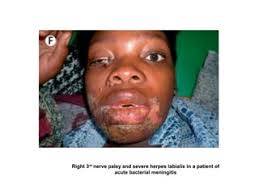Creutzfeldt-Jakob Disease (CJD) is a rare, degenerative, fatal brain disorder caused by infectious prions. It progresses rapidly and affects the nervous system. Here's a detailed look at the signs, causes, effects, and potential solutions.
1. Causes of Creutzfeldt-Jakob Disease
CJD can be caused by various genetic, sporadic, or acquired factors:
1. Sporadic Mutation – Most cases arise spontaneously without any known cause.
2. Genetic Mutation – Inherited mutations in the PRNP gene.
3. Prion Contamination – Exposure to infected tissue during a medical procedure.
4. Inherited CJD – Familial cases passed down through generations.
5. Variant CJD – Linked to consuming contaminated beef with prions (mad cow disease).
6. Iatrogenic CJD – Caused by exposure to prion-contaminated surgical instruments.
7. Growth Hormone Treatments – Especially those derived from human pituitary glands.
8. Dural Grafts – Infection via prion-contaminated dura mater grafts in surgeries.
9. Contaminated Surgical Tools – Prions are highly resistant to sterilization.
10. Blood Transfusion – Rare cases have occurred through contaminated blood products.
11. Age – Typically affects individuals aged 60 and older.
12. Environmental Exposure – Though very rare, accidental prion exposure is possible.
13. Genetic Predisposition – Genetic forms can lead to inherited CJD.
14. Abnormal Protein Folding – Misfolded proteins can lead to prion diseases.
15. Specific Genetic Variants – Certain genotypes increase susceptibility.
16. Neurosurgery Procedures – Exposure to infected neural tissue during brain surgeries.
17. Dental Procedures – Although extremely rare, prion transmission has been speculated.
18. Corneal Transplants – Rare transmission from donor corneas.
19. Animal Exposure – Rare cases from handling infected animal tissue.
20. Unknown Causes – Some cases lack a clear origin (sporadic cases).
2. Signs of Creutzfeldt-Jakob Disease
Symptoms of CJD often start subtly but rapidly progress, including:
1. Memory Loss – Rapid onset of memory impairment.
2. Behavioral Changes – Mood swings, irritability, or depression.
3. Confusion – Cognitive disorientation and difficulty focusing.
4. Poor Coordination – Trouble with balance and coordination.
5. Muscle Stiffness – Rigidity and muscle tightness.
6. Visual Disturbances – Blurred vision, blindness, or hallucinations.
7. Slurred Speech – Difficulty with clear speech and articulation.
8. Twitching – Involuntary muscle jerks or spasms.
9. Fatigue – Extreme tiredness or exhaustion.
10. Dizziness – Lightheadedness or imbalance.
11. Seizures – Uncontrolled convulsions in advanced stages.
12. Personality Changes – Sudden mood swings or irritability.
13. Insomnia – Severe trouble sleeping or restlessness.
14. Apathy – Lack of interest or motivation.
15. Weight Loss – Rapid weight loss due to muscle wasting and lack of appetite.
16. Lack of Bladder/Bowel Control – Incontinence in late stages.
17. Paranoia – Anxiety, paranoia, or delusions.
18. Unsteady Gait – Difficulty walking, leading to frequent falls.
19. Difficulty Swallowing – Dysphagia, leading to choking risk.
20. Loss of Speech – Severe difficulty communicating in later stages.
3. Effects of Creutzfeldt-Jakob Disease
CJD has profound impacts on both physical and mental health, typically leading to death within months to a few years after symptoms start:
1. Complete Loss of Cognitive Function – Rapid dementia and loss of cognitive abilities.
2. Total Physical Dependency – Individuals often require full-time care.
3. Inability to Communicate – Severe speech impairment and loss of language skills.
4. Severe Muscle Wasting – Muscles deteriorate due to immobility and weight loss.
5. Total Loss of Mobility – Paralysis or inability to move independently.
6. Constant Seizures – Frequent seizures that can’t be fully controlled.
7. Chronic Pain – Severe muscle cramps, joint pain, and discomfort.
8. Social Isolation – Reduced social interaction due to loss of communication.
9. Sleep Disorders – Extreme insomnia and disrupted sleep patterns.
10. Imminent Fatality – CJD is ultimately fatal, often within a year of onset.
4. Solutions and Management for Creutzfeldt-Jakob Disease
There is currently no cure for CJD, but supportive treatments can help manage symptoms and improve quality of life:
1. Pain Management – Use of analgesics to ease muscle pain and stiffness.
2. Anti-seizure Medications – Controls seizure activity.
3. Physical Therapy – Maintains mobility as long as possible and improves coordination.
4. Speech Therapy – Helps slow down loss of speech and communication abilities.
5. Counseling and Support – Psychological counseling for patients and family.
6. Nutrition Support – Special diets or feeding tubes to maintain nutrition.
7. Antidepressants – Reduces anxiety and depression related to disease progression.
8. Sedatives – Aids with sleep difficulties and calms agitation.
9. Caregiver Support – Training for caregivers on handling physical and behavioral changes.
10. Hospice Care – Focused on comfort and quality of life during the late stages of CJD.
Preventing CJD largely involves controlling potential prion exposure in healthcare settings, improving sterilization techniques for surgical instruments, and screening donor tissue carefully. Because it’s incurable and rapidly progressive, supportive care is aimed at maintaining comfort, reducing distress, and ensuring dignified end-of-life care.


